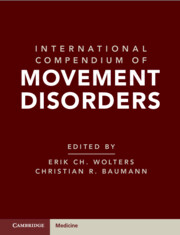Book contents
- International Compendium of Movement Disorders
- International Compendium of Movement Disorders
- Copyright page
- Contents
- Contributors
- International Compendium of Movement Disorders
- Hypo- and Hyperkinetic, Dyscoordinative and Otherwise Inappropriate Motor and Behavioral Movement Disorders
- Section 1: Basic Introduction
- Section 2: Hypokinetic Movement Disorders
- Section 3: Hyperkinetic Movement Disorders
- Chapter 36 Primary Dystonia
- Chapter 37 Secondary Dystonia
- Chapter 38 Treatment of Dystonia
- Chapter 39 Primary and Secondary Tremors
- Chapter 40 The Pathophysiology of Tremor
- Chapter 41 Treatment of Tremor
- Chapter 42 Myoclonus
- Chapter 43 Chorea
- Chapter 44 Ballism
- Chapter 45 Gilles de la Tourette Syndrome and Other Tics
- Section 4: Dyscoordinative and Otherwise Inappropriate Motor Behaviors
- Section 5: Objectifying Movement Disorders
- Movement Disorders in Vivo: Video Fragments
- Acronyms and Abbreviations
- Index
- References
Chapter 45 - Gilles de la Tourette Syndrome and Other Tics
from Section 3: - Hyperkinetic Movement Disorders
Published online by Cambridge University Press: 07 January 2025
- International Compendium of Movement Disorders
- International Compendium of Movement Disorders
- Copyright page
- Contents
- Contributors
- International Compendium of Movement Disorders
- Hypo- and Hyperkinetic, Dyscoordinative and Otherwise Inappropriate Motor and Behavioral Movement Disorders
- Section 1: Basic Introduction
- Section 2: Hypokinetic Movement Disorders
- Section 3: Hyperkinetic Movement Disorders
- Chapter 36 Primary Dystonia
- Chapter 37 Secondary Dystonia
- Chapter 38 Treatment of Dystonia
- Chapter 39 Primary and Secondary Tremors
- Chapter 40 The Pathophysiology of Tremor
- Chapter 41 Treatment of Tremor
- Chapter 42 Myoclonus
- Chapter 43 Chorea
- Chapter 44 Ballism
- Chapter 45 Gilles de la Tourette Syndrome and Other Tics
- Section 4: Dyscoordinative and Otherwise Inappropriate Motor Behaviors
- Section 5: Objectifying Movement Disorders
- Movement Disorders in Vivo: Video Fragments
- Acronyms and Abbreviations
- Index
- References
Summary
Tics are brief, sudden, non-rhythmic, repetitive movements. Tics can be motor or vocal. Further, both motor and vocal tics can be either simple or complex. Simple tics typically involve only one group of muscles and are brief and meaningless, whereas complex tics may last longer and appear more purposeful. Tic disorders usually begin in childhood and are classified according to the Diagnostic and Statistical Manual of Mental Disorders (DSM-5) into four groups: (1) provisional tic disorder, (2) chronic motor or vocal tic disorder, (3) Tourette disorder (or Gilles de la Tourette syndrome), (4) tic disorder not otherwise specified. As tics can resemble almost any other movement disorder, phenotypic analysis alone is insufficient and patients must be questioned whether the execution is preceded by a premonitory sensation (urge to do, urge to move) and whether a temporary control of the movement can be achieved. Also, relief following execution of the tic is frequently reported. There are no biomarkers available for tics and diagnosis therefore remains strictly clinical.
Keywords
- Type
- Chapter
- Information
- International Compendium of Movement Disorders , pp. 559 - 567Publisher: Cambridge University PressPrint publication year: 2025

